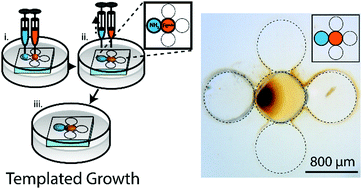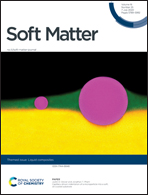Crystallization at droplet interfaces for the fabrication of geometrically programmed synthetic magnetosomes†
Abstract
Biological systems demonstrate exquisite three dimensional (3D) control over crystal nucleation and growth using soft micro/nanoenvironments, such as vesicles, for reagent transport and confinement. It remains challenging to mimic such biomineralization processes using synthetic systems. A synthetic mineralization strategy applicable to the synthesis of artificial magnetosomes with programmable magnetic domains is described. This strategy relies on the compartmentalization of precursors in surfactant-stabilized liquid microdroplets which, when contacted, spontaneously form lipid bilayers that support reagent transport and interface-confined magnetite nucleation and growth. The resulting magnetic domains are polarized and thus readily manipulated using magnetic fields or assembled using droplet–droplet interactions. This strategy presents a new, liquid phase procedure for the synthesis of vesicles with geometrically controlled inorganic features that would be difficult to produce otherwise. The artificial magnetosomes demonstrated could find use in, for example, drug/cargo delivery, droplet microfluidics, and formulation science.

- This article is part of the themed collection: Liquid Composites


 Please wait while we load your content...
Please wait while we load your content...